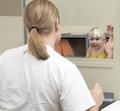 A new study, funded by a grant from the National Institutes of Health, finds that infants as young as three months begin to classify facial images by race and gender and show a preference for those that they see most often in their daily lives. The results show that by nine months, infants have difficulty recognizing the faces of people from less familiar groups.
A new study, funded by a grant from the National Institutes of Health, finds that infants as young as three months begin to classify facial images by race and gender and show a preference for those that they see most often in their daily lives. The results show that by nine months, infants have difficulty recognizing the faces of people from less familiar groups.
One of the researchers on the project, Paul Quinn a professor of sociology at the University of Delaware, stated: “At 3 months of age, the Caucasian infants we studied showed a looking-time preference for Caucasian faces, and when we collaborated with researchers in China, we found the same preference among Asian infants for Asian faces.” Most infants are exposed predominantly to members of one racial group, generally their own. “Also at 3 months, infants had the ability to tell apart different faces within their own race as well as within other racial groups, but by 9 months, they had lost that ability for races other than their own,” Professor Quinn said. “It seems that, as time goes on during the infancy period, and we experience some categories more frequently than others, we begin to process those categories differentially.”
The research is conducted in the laboratory by showing infants photographs of faces and measuring the time the infants studied the images. As objects become more familiar, the babies spent less time looking at them. “That process may provide the initial starting point on the pathway to adult concept formation, where information and memories are stored in our minds in categories, like folders in a file cabinet,” Professor Quinn said.











